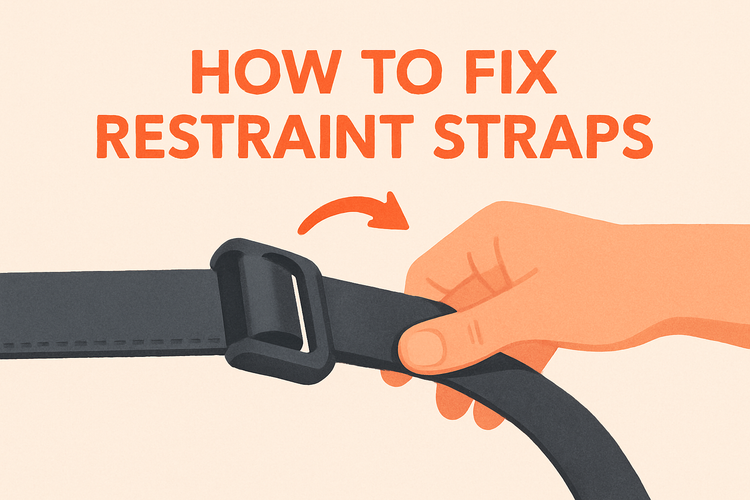How To Fix Restraint Straps

Understanding the Purpose of Restraint Straps
Restraint straps play a crucial role in maintaining the structural stability of buildings. They're designed to tie walls and floors together securely, preventing movement or separation, particularly under high wind pressure or external stress.
They're typically installed in timber-framed buildings to meet building regulation requirements and ensure long-term integrity. Understanding how these components function is the first step toward addressing any issues related to their performance. When installed incorrectly or damaged over time, restraint straps can compromise structural strength and safety.
These straps are commonly used in conjunction with other structural hardware such as post bases or joist hangers to complete a reinforced network. Poorly secured restraint straps won’t perform as intended, which is why fixing them promptly is essential. Identifying the root cause of failure helps ensure lasting fixes and improved stability.
Common Problems with Restraint Straps
Even high-quality restraint straps can face issues over time due to weather exposure, structural shifts, or installation errors.
One common problem is corrosion, especially in environments susceptible to high humidity. Galvanised or stainless-steel restraint straps are designed to resist rust, but if they were poor-quality or the protective coating has worn, they may degrade faster. Mechanical damage during renovation or wood swelling from moisture can also contribute to instability, loosening the strap's grip over time.
Improper installation is another significant issue. If screws or nails aren't anchored securely or if the strap is fitted at the wrong angle, it won't provide the necessary lateral support between walls and floors. It’s also possible that the timber framework has shifted due to load adjustments or settling, causing strain on the restraint straps. In such cases, evaluating nearby components like joist hangers can reveal contributing factors and help assess the full scope of repair.
Tools and Materials Needed for Repairs
Before you begin any repair work on restraint straps, it’s vital to have the correct tools and materials prepared to ensure a smooth and effective process.
At a minimum, you’ll need new restraint straps that are suitable for the application in question, along with heavy-duty nails or screws—preferably those recommended for use in structural timber. Depending on your building type, you might also need a bracket or post base for additional reinforcement. A power drill, hammer, level, stud finder, and protective gear like gloves and goggles will also come in handy.
It's a good idea to inspect nearby structural elements as well. If straps were originally attached improperly due to weak or misaligned joists, installing new ones without correcting the actual anchoring surface could be counterproductive. In timber-frame constructions, consider evaluating the need for updated timber frame connectors which may offer a more robust solution alongside the replacement of older straps.
Step-by-Step Guide to Fixing Restraint Straps
The repair process will vary based on the specific issue, but the general approach follows a clear and consistent pattern to ensure proper reinforcement.
Begin by removing any damaged or loose restraint straps. If they're nailed in, use a claw hammer or pry bar to extract them gently to avoid harming the timber. Where screws were used, a suitable power drill will speed up the removal. Inspect the structural timber around the anchoring site carefully to make sure it hasn’t rotted or cracked. If it has, reinforce it with either new supports or strategically placed post bases for vertical support.
Next, position a new restraint strap in line with the old one, ensuring it stretches across at least three joists or studs if possible. The strap should contour tightly to the timber’s surface and be anchored using corrosion-resistant fasteners. If additional anchorage is needed for wind-loading zones, use high wind ties to provide added resilience. Finally, double-check your alignment and fixings for tightness and compliance with local building codes.
Maintaining Restraint Straps for Long-Term Durability
Once fixed or newly installed, proper maintenance is key to ensuring restraint straps remain effective across years of structural strain and environmental exposure.
Start with periodic visual inspections, ideally twice a year or after significant weather events. Look for any signs of loosening, rust, or cracking of timber around the strap. Moisture is one of the biggest enemies of metal fixtures, so ensuring your building has good ventilation and moisture-control measures will prolong strap life. If you notice surface corrosion beginning to form, gently remove rust with a wire brush and apply a rust-inhibitor coating.
In environments prone to high wind or shifting foundations, additional consultations with a contractor may be required to assess whether the original restraint placement is still suitable. Consider using specialty products like high wind ties as supplementary supports if local building regulations or wind zones demand it. Staying proactive with maintenance can help you avoid costly structural issues and ensure ongoing safety.
